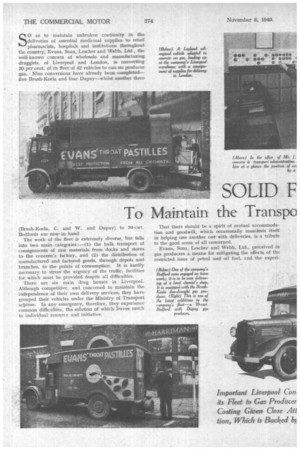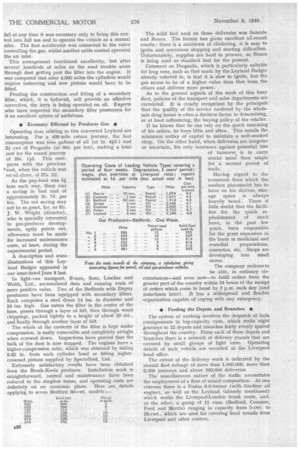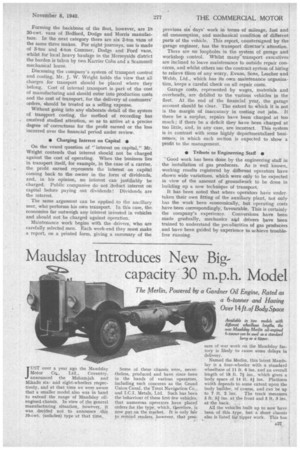SOLID F -EL HELPS
Page 26

Page 27

Page 28

Page 29

If you've noticed an error in this article please click here to report it so we can fix it.
To Maintain the Transpo of Urgent Medical Supplies
SO as to maintain unbroken continuity in the deliveries of essential medicinal supplies to retail pharmacists, hospitals and institutions throughout the country, Evans, Sons, Lescher and Webb, Ltd., the well-known concern of wholesale and manufacturing druggists, of Liverpool and London, is converting 30 per cent, of its fleet of 42 vehicles to run on producer gas. Nine conversions have already been completed— five Brush-Koela and four Dupuy—whilst another three
(Brush-Koela, C. and W. and Dupuy) to 30-cwt. Bedfords are now in hand The work of the fleet is extremely diverse, but falls into two main categories:—(1) the bulk transport of consignments of raw materials from docks and stores to the concern's factory, and (2) the distribution of manufactured and factored goods, through depots and branches, to the points of consumption. It is hardly necessary to stress the urgency of the traffic, facilities for which must be provided despite all difficulties.
There are six main drug houses in Liverpool. Although competitive, and concerned to maintain the independence of their own delivery services, they have grouped their vehicles under the Ministry of Transport scheme. In any emergency, therefore, they experience common difficulties, the solution of which leaves much to individual resource and initiative. That there should be a spirit of mutual accommodation and goodwill, which occasionally manifests itself in helping one another out with deliveries, is a tribute to the good sense of all concerned.
Evans, Sons, Lescher and Webb, Ltd., perceived in gas producers a means for mitigating the effects of the restricted issue of petrol and oil fuel, and the experi mental work it has done has provided a useful basis of discussion amongst discerning operators. Although the results from vehicles, now in service have been variable within fairly wide limits, thecompany has no reason to doubt the ultimate success of the gas producer as an economic and efficient apparatus for road-transport work. Before that happy position can be reached, however, it will be necessary to secure ample supplies of the right quality of fuel—a subject on which there is-scope for considerable research—and to train drivers, who need to be sufficiently alert, patient and understanding, to get the best from the new plants in the wide range of circumstances that they may encounter.
The first experiment was with a Leyland Badger (5-tonner) powered by a four-cylindered compression.
ignition engine. The unit was converted to run on petrol, in the first instance, and then a Dupuy gas producer was added. After the alteration the engine functioned moderately well on gas, but if a change-over to petrol was called for it laboured and became subject to heavy wear, the reason for this being the high compression and pre-ignition.
The next experiment was to return the engine to its normal condition (as an oil unit) and to run on oil fuel and gas. The injection-pump rack was disconnected from the accelerator and was connected, instead, to a Bowden-type cable control and adjusted so that, in the " off" position, the engine was kept idling with the vehicle stationary.
This setting was required in order to detonate the gas and the engine was driven "on gas" without any further alteration to the pump control. Should the gaa fail at any time it was necessary only to bring this control into full use and to operate the vehicle as a normal oiler. The foot accelerator was connected to the valve controlling the gas, whilst another cable control operated the air inlet.
This arrangement functioned excellently, but after several hundreds of miles on the road trouble arose through dust getting past the filter into the engine. It was computed that after 4,000 miles the cylinders would require resleeving and new pistons would have to be fitted.
Pending the construction and fitting of a secondary filter, which, it is believed, will provide an effective corrective, the lorry is being operated on oil. Experts who have inspected the secondary filter pronounce for it an excellent sphere of usefulness.
• Economy Effected by Producer Gas • Operating data relating to this converted Leyland are interesting. For a 408-mile return journey, the fuel consumption was nine gallons of oil (at 1s. 4/d.) and 3i cwt of Frogasite (at 90s. per ton), making a total cost for the round journey of 28s. lid. This cornpares with the previous 'cost, when the vehicle was on oil alone, of 37s. 2d.
As the pay-load was S. tons each way, there was a saving in fuel cost of approximately 2s. 7d. per ton. The net saving may not be so great, for, as Mr. J. W. Wright (director), who is specially interested in gas-producer developments, aptly points out, allowance must be made for increased maintenance costs, at least, during the experimental period.
A description and some illustrations of this Leyland Badger appeared in our issue dated June 8 last.
In light-van transport, Evans, Sons, Lescher and Webb, Ltd., accumulated data and running costs of more positive value. Two of the Bedfords with Dupuy producers have been equipped with secondary filters. Each comprises a steel drum 14 ins, in diameter and 24 ins. high. Gas enters the filter ip the centre of the , base, passes through a layer of felt, then through wood chippings, packed tightly to a height of about 20 ins., and finally through another layer of felt.
The whole of the contents of the filter is kept Under compression, is easily removable and completely airtight when screwed down. Inspections have proved that the bulk of the dust is now trapped. The engines have a higher-compression ratio, which was obtained by taking 3-32 in. from each cylinder head or fitting highercrowned pistons supplied by Specialloid, Ltd.
Extremely satisfactory results have been obtained from the Brush-Koela producer. Installation work is straightforward, control and maintenance have been reduced to the simplest terms, and operating costs are definitely on an economic plane. Here are details applying to seven Bedford 30-cwt. models :—
Make Morris Commer
Bedford Dodge
Commer
Foden „ Leyland Capacity 10 cwt.
ton 30 cwt.
2 ton
3 con
5 eon
6 ton 1
„ 2
386 329 • 335 ▪ 565 529 481
" 9 "
4
„
„ 6
Solki inel Petrol
Miles. in lb. in galls. 492 448 3
652 sos a
157 112 1 177 108 10 500 570 15
479 336 15
518 392 14
The solid fuel used on these deliveries was Suncole and Rexco. The former has given excellent all-round results ; there is a minimum of clinkering, it is easy to ignite and minimizes stopping and starting difficulties. Unfortunately, supplies are hard to procure, so Rexco is being used as standard fuel for the present.
Comment on Progasite, which is particularly suitable for long runs, such as that made by the Leyland Badger already referred to, is that it is slow to ignite, but the gas seems to be of a higher value than that -from the others and delivers more power.
As to the general aspects of the work of this busy fleet, policies of the transport and sales departments are correlated. It is clearly recognized by the principals that the quality of the service rendered by the wholesale drug house is often a decisive factor in determining, or at least influencing, the buying policy of the retailer.
If he knows that he can rely on the quick executing of his orders, he buys little and often. This entails the minimum outlay of capital to maintain a well-stocked shop. On the other band, when deliveries are irregular or uncertain, his Only insurance against potential loss of turnover is to carry stocks more than ample for a normal period of trade.
Having regard to the numerou's lines which the modern pharmacist has to have on his shelves, storage space is always heavily taxed. There little doubt that the facilities for the quick replenishment of stock have, in the past few years, been responsible for the great expansion in the trade in medicinal and remedial preparations, cosmetics, etc. Shops are developing into small stores.
The company reckons to be able, in ordinary circumstances—and even now—to fulfil orders from the greater part of the country within 24 hours of the receipt of orders which come to hand by 3 p.m. each day (and sometimes later). rt has a widespread and flexible organization capable of coping with any emergency.
• Feeding the Depots and Branches • The system of working involves the despatch of bulk consignments in big-capacity vans, which make night iourneys to 12 depots and branches fairly evenly spaced throughout the country. From each of these depots and branches there is a network of delivery rounds that are covered by small groups of fight vans. Operating details of each_vehicle are recorded at the Liverpool head office.
The extent of the delivery work is indicated by the annual fleet mileage of more than 1,000,000, more than 3,000 journeys and about 100,000 deliveries.
The miscellaneous nature of the traffic necessitates the employment of a fleet of mixed composition. At one extreme there is a Foden 6-8-tonner (with Gardner oil engine), as well as the Leyland (already mentioned) which works the Liverpool-London trunk route, and, at the other, a group of 11 vans (Bedford, Commer, Ford and Morris) ranging in capacity from 5-cwt. to 20-cwt., which are used for covering local rounds from Liverpool and other centres.
Forming the backbone of the fleet, however, are 18 30-cwt. vans of Bedford, Dodge and Morris manufacture. In the next category there are six 2-ton vans of the same three makes. For night journeys, use is made of 8-ton and 4-ton Commer, Dodge and Ford vans, whilst for local heavy haulage in the Merseyside district the burden is taken by two Karrier Cobs and a Scammell mechanical horse.
Discussing the company's system of transport control and costing, Mr. J. W. Wright holds the view that all charges for transport should be placed where they belong. Cost of internal transport is part of the cost of manufacturing and should enter into production costs and the cost of transport, for the delivery of customers' orders, should be treated as a selling expense.
Without going into any elaborate detail of the system of tran§port costing, the method of recording has received studied attention, so as to arrive at a precise degree of correctness for the profit earned or the loss incurred over the financial period under review.
• Charging Interest on Capital • On the vexed question of "interest on capital," Mr. Wright contends that interest should not be charged against the cost of operating. When the business lies in transport itself, for example, in the case of a carrier, the profit earned represents the interest on capital coming back to the owner in the form of dividends, and, in his opinion, no interest can justifiably be charged. Public companies do not deduct interest on capital before paying out dividends! Dividends are the interest.
The same argument can be applied to the ancillary user, who performs his own transport. In this case, the. economies far outweigh any interest invested in vehicles and should not be charged against Operation.
Maintenance work begins with the drivers, who are carefully selected men. Each week-end they must make a report, on a printed form, giving a summary of the previous six days' work in terms of mileage, fuel and oil consumption, and mechanical condition of different parts of the vehicle. This report, countersigned by the garage engineer, has the transport director's attention.
These are no loopholes in the system of garage and workshop control. Whilst many' transport executives are inclined to leave maintenance to outside repair concerns, and whilst others use the contract system of hiring to relieve them of any worry, Evans, Sons, Lescher and Webb, Ltd., which has its own maintenance organization, keeps a careful check on all repair costs.
Garage costs, represented by wages, materials and overheads, are debited to the various vehicles in the fleet. At the end of the financial year, the garage account should be clear. The extent to which it is not is the margin of inaccuracy in costing out jobs. If there be a surplus, repairs have been charged at too much; if there be a deficit they have been charged at too little, and, in any case, are incorrect. This system is in contrast with some highly departmentalized businesses, in which each section is expected to show a profit to the management.
• Tribute to Engineering Staff •
'Good work has been done by the engineering staff in the installation of gas producers. As is well known, working results registered by different operators have shown wide variations, which were only to be expected in view of the amount of groundwork to be done in building up a new technique of transport.
It has been noted that where operators haYe undertaken their own fitting of the auxiliary plant, not only has the work been economically, but operating costs have been correspondingly, favourable. This is certainly the company's experience. Conversions have been made gradually, mechanics and drivers have been trained to understand the peculiarities of gas producers and have been guided by experience to achieve troublefree running.




















































